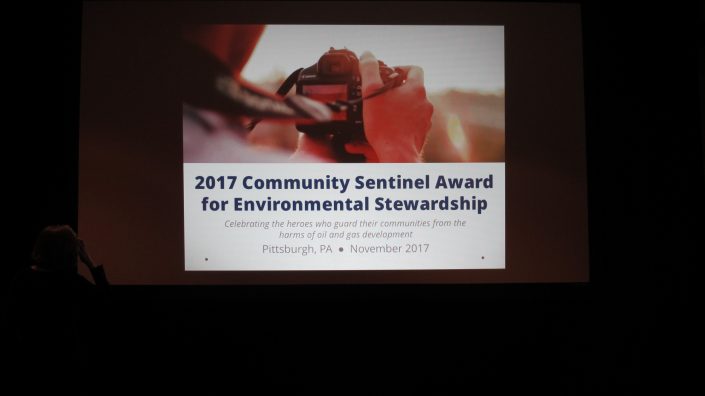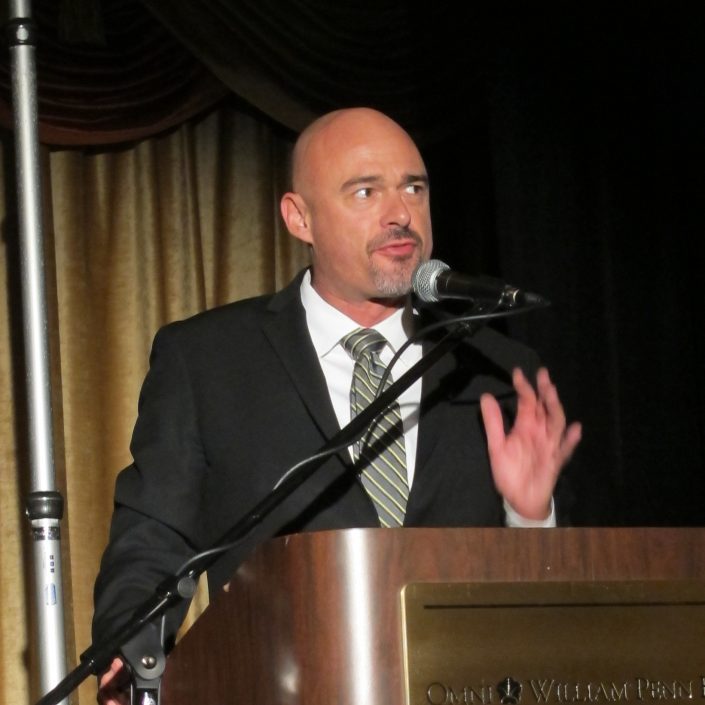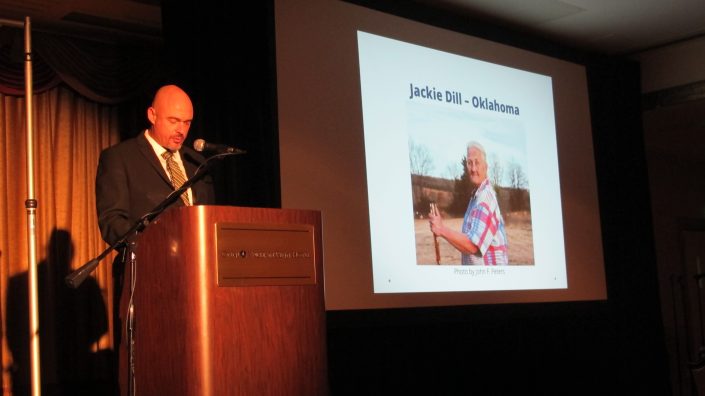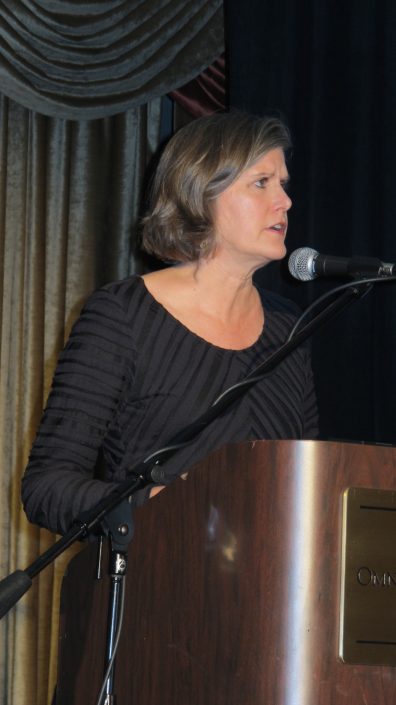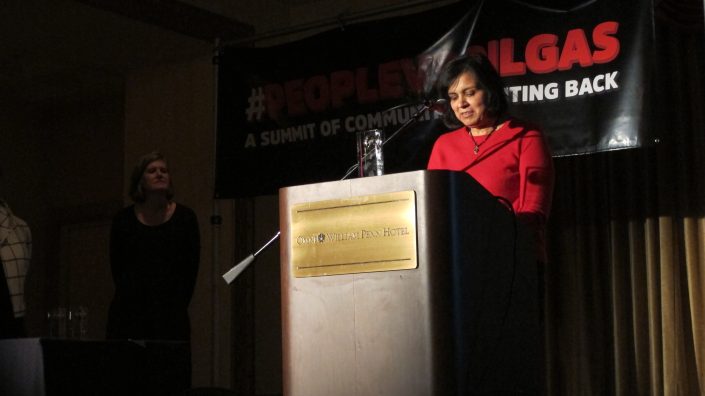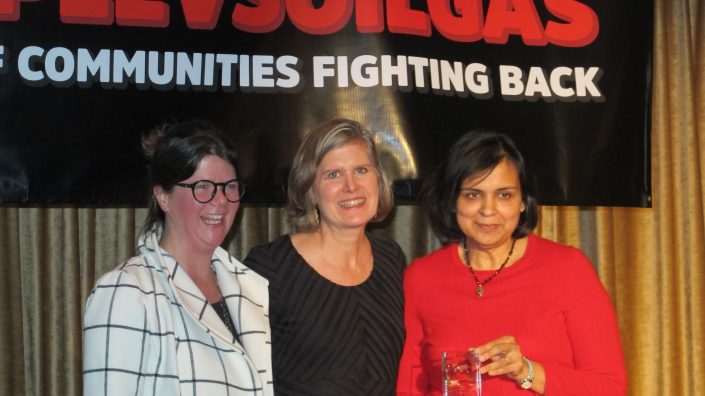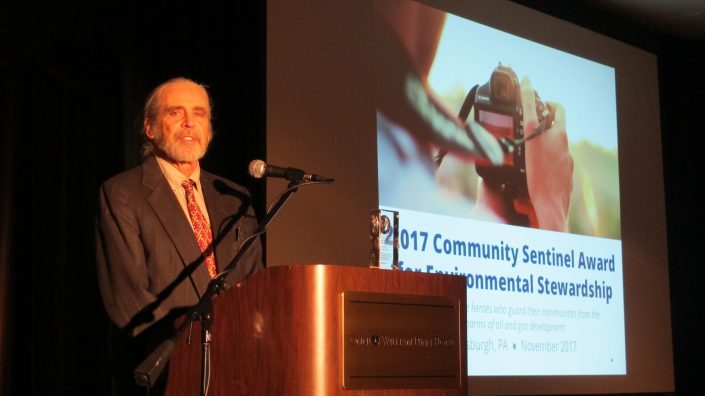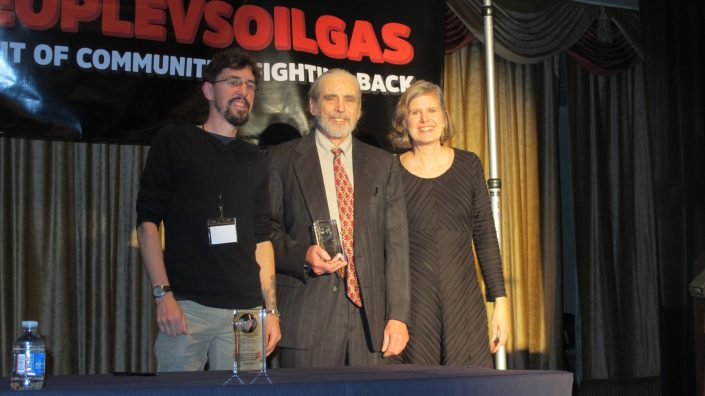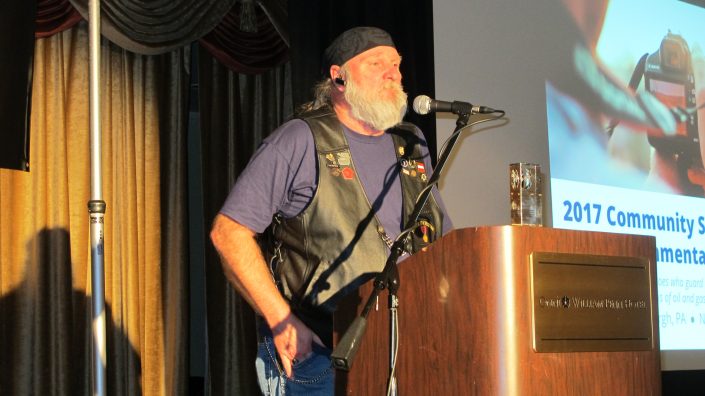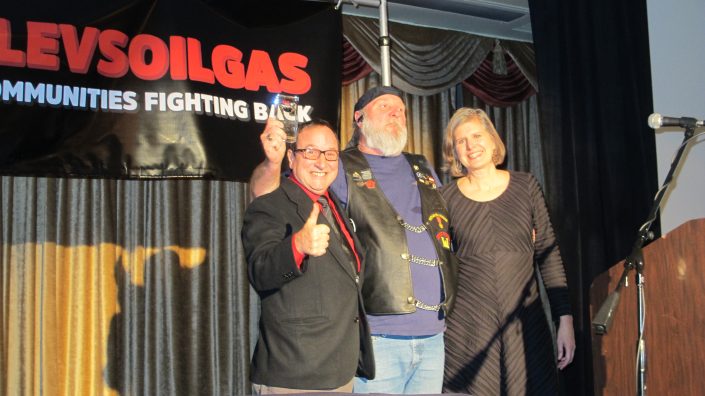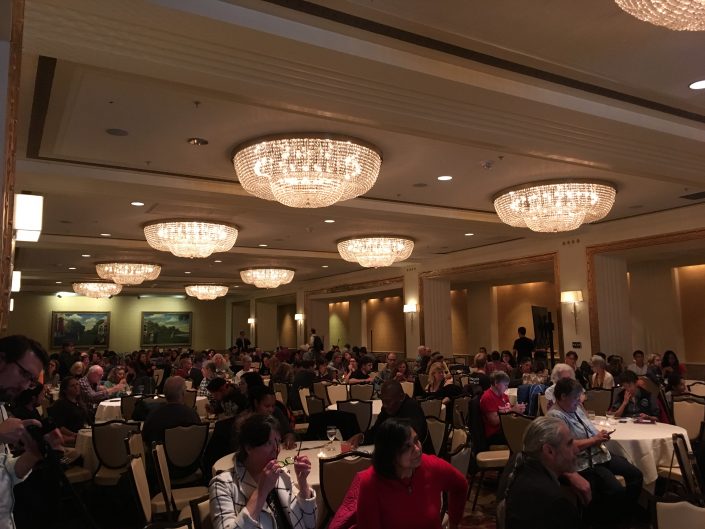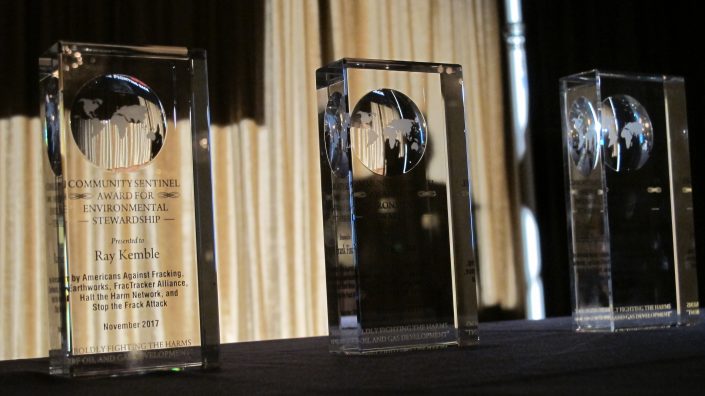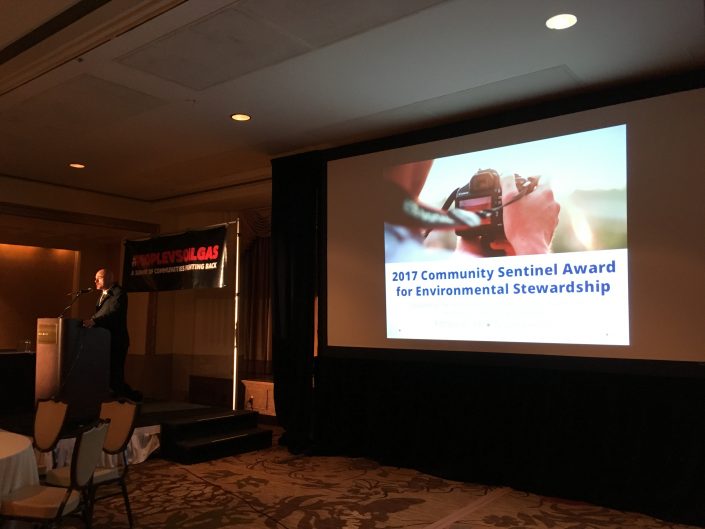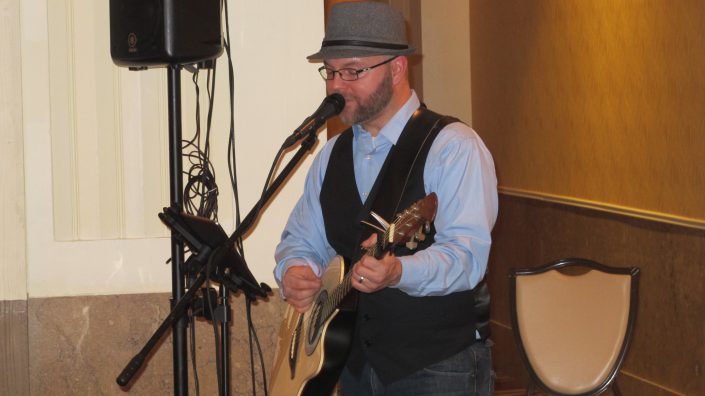Reflections from the 2017 Community Sentinel Award Program
The Community Sentinel Award for Environmental Stewardship, launched in 2015, is awarded each year to three people who work to guard their communities from the harms of oil and gas development. Below is a reflection of the 2017 honorees and Community Sentinel Award Program held on November 18, 2017 in Pittsburgh, PA.
This year, 18 people were nominated by their peers to receive this distinguished award. These nominees were reviewed by a committee of community defense leaders (judges listed below). With the help of our Award Partners, we presented the 2017 Community Sentinel award to: Ranjana Bhandari, Frank Finan, and Ray Kemble. Each awardee received $1,000 to perpetuate their efforts.
The award ceremony, attended by ~300 people, was graciously emceed by David Braun of Rootskeeper. Recipients were introduced enthusiastically by Jennifer Krill of Earthworks, Ryan Clover-Owens of Halt the Harm Network, and Doug Shields of Food and Water Watch. After giving their very moving acceptance speeches, Ranjana, Frank, and Ray were then presented with their awards by acclaimed author and ecologist, Sandra Steingraber.
Community Sentinel Award Recipients
Ranjana Bhandari, though humble and quiet, is an outspoken advocate for clean air and water. When urban fracking came to her town, she took the initiative to form a grass roots organization. In 2017, she worked tirelessly for many months organizing a successful opposition to a proposed wastewater injection well that was to be installed on the banks of her town’s drinking water supply.
Frank Finan is an unsung hero of the Marcellus Shale, through both his work documenting emissions using his FLIR camera and his selfless donations of talent, skills, and labor when his neighbors are in need. He made it his mission to help families who were becoming ill from highly concentrated spikes of pollution.
Ray Kemble has been at the center of fighting fracking from day one as a resident of Dimock, Pennsylvania. Despite recently breaking has back and undergoing an operation for cancer, he will not be deterred from seeking justice for the harmed.
Legacy of Heroes Presentation
In addition to the Community Sentinels, we also recognized activists who could not be with us during a special Legacy of Heroes presentation. This presentation recognized the efforts of four people who valiantly fought against the harms of dirty energy but passed away in the last year: Walter Brasch of Pennsylvania, Rosemarie Braz of California, Jackie Dill of Oklahoma, and Kaye Fissinger of Colorado.
Walter Brasch, of Bloomsburg, Pennsylvania, was professor emeritus of mass communications and journalism at Bloomsburg University and an award-winning reporter and author who turned his attention to fracking when the boom overtook PA. His critically-acclaimed book, Fracking Pennsylvania: Flirting with Disaster, explored the controversies surrounding shale gas development in his home state.
From apartheid to the prison-industrial complex to climate change, Rose Braz fought injustice in all its many forms. An incredible strategist, facilitator and mentor, she led and inspired a generation of activists. As the Center for Biological Diversity’s Climate Campaign Director from 2009 until her death, and Co-founder of Californians Against Fracking, Rose worked passionately to protect people from fracking and dangerous drilling.
Jackie Dill described herself as a heritage wildcrafter, practicing and teaching others to use wild plants for food, spices, healing, and crafts. Oil and gas companies developed wells around her home, and fracking-induced earthquakes severely damaged it. Jackie was known for speaking out about these issues, with features in Time and Newsweek.
Kaye Fissinger, of Longmont, Colorado, was a force of nature. The effort she led to ban fracking via an historic ballot initiative attracted the attention of The New York Times and PBS, among other national media. A founding member of Americans Against Fracking, Kaye helped change the conversation about fracking.
On behalf of all of the award partners and sponsors, a heartfelt thank you goes out to these incredible advocates.
Ceremony Photos
Complete Award and Program Details
Nominees and Recipients
- Gustavo Aguirre Jr. – Central CA EJ Network – Bakersfield, CA
- Heather Andersen – Save The Hills Alliance – Bloomer, WI
- Alice Arena – FRRACS – Weymouth, MA
- Ranjana Bhandari – Liveable Arlington – Arlington, TX **
- Lois Bower-Bjornson – CCJ, CAC, Sierra Club, etc. – Scenery Hill, PA
- Malinda and Mark Clatterbuck – Lancaster Against Pipelines – Holtwood, PA
- Robert Donnan – Community Resident – McMurray, PA
- Karen Feridun – Berks Gas Truth – Kutztown, PA
- Frank Finan – Community Resident – Hop Bottom, PA **
- Kim Fraczek – Sane Energy Project – Brooklyn, NY
- Anne Marie Garti – Stop the Pipeline – Bronx, NY
- Elise Gerhart – Camp White Pine – Huntingdon, PA
- Nadine Grabania – Don’t Frack Maryland – Frostburg, MD
- Carrie Hahn – CAUSE – Volant, PA
- Ray Kemble – Community Resident, Montrose, PA **
- Ann Nau – Community Resident – Myersville, MD
- Courtney Williams – resistaim.org / resistspectra.org – Peekskill, NY
- Leonard Zuza – Community Resident – Solomons, MD
** Indicates 2017 Award Recipient
Legacy of Heroes Remembrance
- Walter Brasch of Pennsylvania
- Jackie Dill of Oklahoma
- Kaye Fissinger of Colorado
- Rosemarie Braz of California
If there are additional community heroes who passed away this year that you would like us to list above, we would be happy to include them. Please email us: info@fractracker.org.
Judges
- Bill Hughes of Wetzel County Action Group, West Virginia
- Pat Popple of Save the Hills Alliance, Wisconsin
- Sierra Shamer of Shalefield Organizing Committee, Pennsylvania
- Dante Swinton of Energy Justice, Maryland
- Niki Wong of Redeemer Community Partnership, California
Partners
- Americans Against Fracking
- Earthworks
- FracTracker Alliance
- Halt the Harm Network
- Stop the Frack Attack
Sponsors
- 11th Hour Project
- DiveIn (Booklet sponsor)
- Foundation for Pennsylvania Watersheds
Many thanks to the organizers and attendees of the People vs. Oil and Gas Infrastructure Summit, during which the Community Sentinel award ceremony was conducted.
